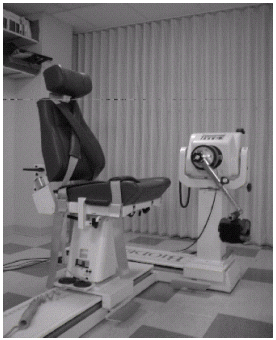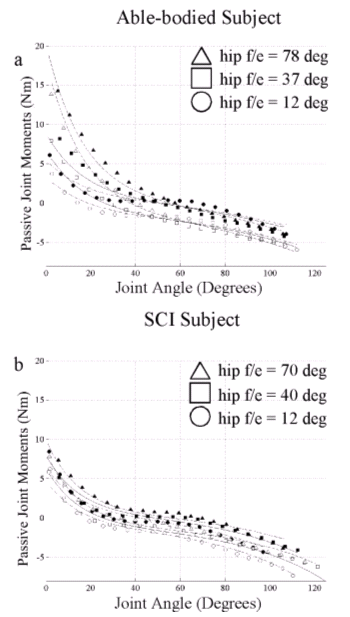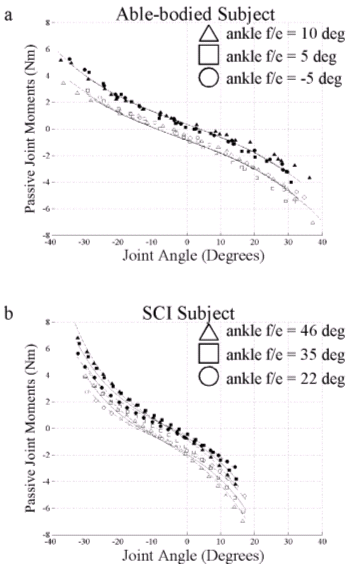THE EFFECTS OF SPINAL CORD INJURY ON THE PASSIVE PROPERTIES OF THE LOWER EXTREMITIES
ABSTRACT
The purpose of this study was to determine the effects of spinal cord injury (SCI) on the passive properties (viscosity and stiffness) of the lower extremity joints. Isokinetic tests were performed to measure the passive moments at the ankle, knee, and hip joints in both the sagittal and coronal planes. Joint angle, joint velocity, and adjacent joint angles were varied to account for their influences. Using the acquired data, an 11-parameter nonlinear viscoelastic model was fitted to the measurements. Comparisons between the moment curves of the two subject populations showed some differences and many similarities in shape and magnitudes. Future work will include incorporating these modeled passive moments into a larger musculoskeletal model of the lower extremities to examine the impact of passive properties on the sit-to-stand transition and standing balance.
BACKGROUND
 |
RESEARCH QUESTION
The goal of this study was to determine whether lower extremity passive properties differed between SCI and able-bodied populations, and whether or not those differences were functionally significant. We measured and compared passive moments in 4 individuals with SCI and 5 able-bodied individuals and investigated the influence of neighboring joint position. Specifically, passive moments were measured for ankle inversion/eversion and hip abduction/adduction, in addition to the more typical measurements of ankle, knee, and hip flexion/extension. The MetroHealth Medical Center and Cleveland VA Medical Center Institutional Review Boards approved the experimental protocol, and each subject provided informed consent to participate.
METHODS
Data were recorded during 7 isokinetic trials performed on a Biodex 3® dynamometer [www.Biodex.com]. In addition, a JR3® [www.JR3.com] force and moment transducer was mounted to the spindle of the dynamometer to obtain more accurate and higher resolution signals for all six axes (Figure 1). The primary joint angle, the angular velocity applied to the joint, and the positions of the proximal and distal joints were varied systematically throughout the trials. The proximal and distal joint angles were fixed during each trial by external braces. For all of the joints tested, the angular velocities and adjacent joint angles were chosen to cover those encountered during a sit-to-stand transition [5, 6]. As in previous studies [3], the joint was preconditioned through 20 cycles of its range of motion (ROM) so that the moment measurements would not be history dependent. During each trial, the joint was cycled through its ROM 15 times. The last 5 cycles were utilized for the data analysis. With the obtained data, a nonlinear viscoelastic model was fitted to allow comparisons to be made between the two subject populations.
RESULTS
 |
For ankle dorsiflexion, the knee angle had an influence on the ankle moment due to the biarticular gastrocnemius muscle. However, at the knee joint the ankle plantarflexion/dorsiflexion had little influence on the knee passive moment. At the knee joint, the hip flexion/extension angle did affect the knee moments of the able-bodied subjects but not the SCI subjects (Figure 2). Since the hip and the knee joints are coupled through the hamstring and the rectus femoris muscles, this suggests a diminished hamstring effect in the SCI group. Yet the coupling between the knee and hip did result in the knee angle having an influence on the hip flexion/extension passive moment in both subject populations. Hip abduction/adduction was expected to have an influence on the hip flexion/extension moment. However, this did not occur. Similarly ankle flexion/extension was expected to affect the ankle inversion/eversion moment because of the numerous muscles that cross both joints. However, no interaction was observed.
The amount of hysteresis (viscosity) at the inflection
point of the passive moment curves was utilized to compare
the viscoelastic properties between subject populations[8].
The amount of hysteresis exhibited was not significantly
different between the two populations. The hysteresis magnitude
changed very little for both subject populations for angular
velocities above 10 deg/s.
DISCUSSION
 |
The passive moment measurements obtained in this study will be incorporated into a bipedal musculoskeletal model of the lower extremities, pelvis and trunk. With the musculoskeletal model, we will simulate how the passive properties of individuals can affect their stability during standing. Also methods of changing passive properties to increase one's stability during standing will be examined. The knowledge gained through these studies will enable us to develop better control systems for users of FES standing and walking systems.
REFERENCES
- Yoon, Y.S. and J.M. Mansour, The passive elastic moment at the hip. J Biomech, 1982. 15(12): p. 905-10.
- Edrich, T., Riener R., Quintern, J., Analysis of Passive Elastic Joint Moments in Paraplegics. IEEE Transactions of Biomedical Engineering, 2000. 47(8): p. 1058-1065.
- Vrahas, M.S., R.A. Brand, T.D. Brown, and J.G. Andrews, Contribution of passive tissues to the intersegmental moments at the hip. J Biomech, 1990. 23(4): p. 357-62.
- Burnham, R., T. Martin, R. Stein, G. Bell, I. MacLean, and R. Steadward, Skeletal muscle fibre type transformation following spinal cord injury. Spinal Cord, 1997. 35(2): p. 86-91.
- Kralj, A., R.J. Jaeger, and M. Munih, Analysis of standing up and sitting down in humans: definitions and normative data presentation. J Biomech, 1990. 23(11): p. 1123-38.
- Kotake, T., N. Dohi, T. Kajiwara, N. Sumi, Y. Koyama, and T. Miura, An analysis of sit-to-stand movements. Arch Phys Med Rehabil, 1993. 74(10): p. 1095-9.
- Mansour, J.M. and M.L. Audu, The passive elastic moment at the knee and its influence on human gait. J Biomech, 1986. 19(5): p. 369-73.
- Esteki, A. and J.M. Mansour, An experimentally based nonlinear viscoelastic model of joint passive moment. J Biomech, 1996. 29(4): p. 443-50.
Kofi
Amankwah
2500 MetroHealth Dr, H601
Cleveland, OH 44109
Office: 216-778-1424
Email:kaa2@cwru.edu
